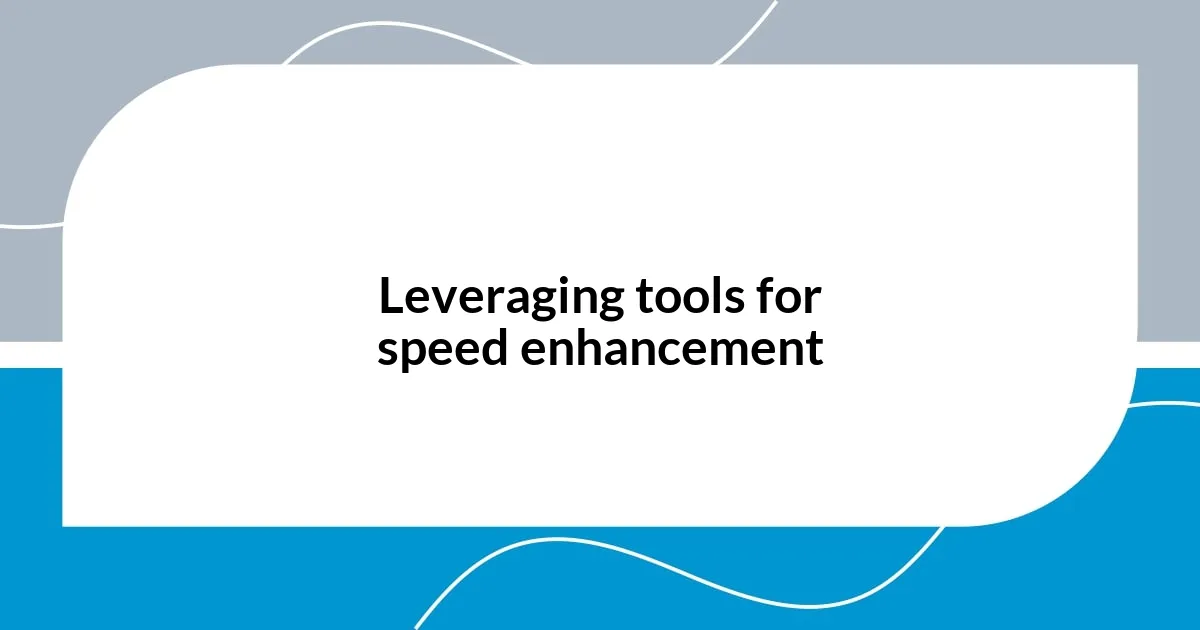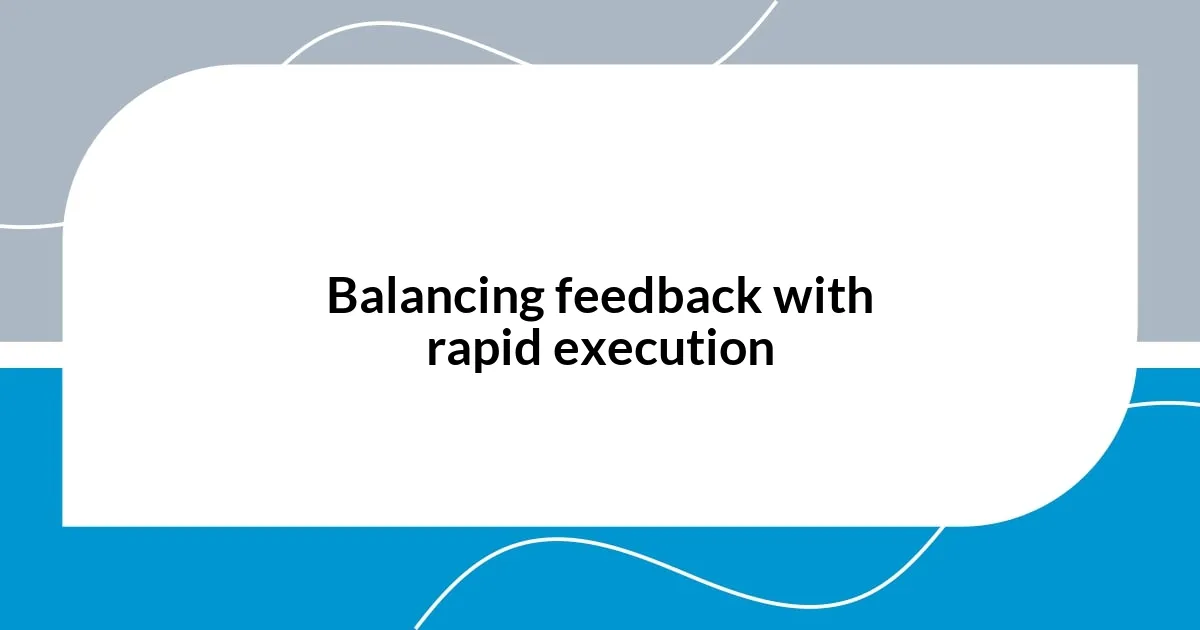Key takeaways:
- Balancing speed and quality is crucial for project success; prioritizing quality builds trust and improves skills.
- Setting clear priorities and using time management techniques, like the Pomodoro Technique and time blocking, enhances productivity.
- Regularly reviewing processes helps identify bottlenecks, enabling adjustments that boost efficiency and maintain quality.
- Embracing feedback fosters collaboration and improves outcomes, reinforcing the idea that feedback enriches rather than hinders quality.

Understanding speed and quality importance
Speed and quality are two sides of the same coin that can significantly influence the success of any project. I remember a time when I rushed to meet a deadline, only to find that the final product had several flaws. It made me realize that while speed can get you to the finish line quickly, quality is what keeps your work standing out. Have you ever considered how often you compromise quality just to save time?
When tackling a project, the balance between speed and quality can often feel like navigating a tightrope. One day, I was under pressure to deliver a marketing campaign quickly. I opted for a shortcut on design, thinking it wouldn’t matter much. The backlash taught me that clients notice—and appreciate—the details. The connection I built through the quality of my work outweighs the fleeting satisfaction of fast delivery. How do you gauge when it’s time to slow down and focus on quality?
Ultimately, speed without quality can lead to a cycle of rework and dissatisfaction, both for yourself and for your clients. I’ve felt that wave of panic when realizing a rushed assignment might impact my professional reputation. It forces me to ask: how do I want to be remembered in my field? By choosing to prioritize quality in some tasks, I not only enhance my skills but also lay the groundwork for lasting trust. So, what’s your take on this balance — have you ever felt the pressure to choose speed over quality?

Setting clear priorities for tasks
Setting clear priorities for tasks is crucial when aiming for the right balance between speed and quality. I’ve found that when I take a moment to outline what truly needs attention, distractions fade away. For instance, during a hectic week, I once spent a few minutes ranking my tasks by urgency and importance, which completely transformed my approach. I learned that not all tasks are created equal.
Here are some ways I set clear priorities:
- Identify urgent deadlines: Recognizing what needs to be done immediately helps me focus without losing sight of quality.
- Evaluate impact versus effort: I assess which tasks will yield significant results for the time invested, allowing me to allocate my energy wisely.
- Break large projects into manageable parts: By doing this, I can tackle each section with intention, ensuring I maintain quality throughout the process.
By establishing priorities, I ensure that I’m not merely chasing speed but also investing in the quality of my work.

Implementing time management techniques
Implementing time management techniques is essential to maintain equilibrium between speed and quality. I’ve discovered that using tools like the Pomodoro Technique can dramatically enhance my productivity. By working in focused bursts followed by short breaks, I find that my concentration sharpens, reducing the temptation to rush through tasks. Have you ever tried breaking your work into intervals? The rhythm not only keeps me motivated but also inspires the kind of quality I strive for.
Another approach that’s worked wonders for me is time blocking. I allocate specific time slots for distinct tasks on my calendar and guard these blocks fiercely. Once, I dedicated a full morning to an important presentation without interruptions. The result was a thorough piece of work I felt proud to present, and it truly showcased my skills without cutting corners. How do you organize your time to ensure you aren’t just moving fast, but moving effectively?
Lastly, I often use a simple daily planner to jot down my goals and tasks. It sounds elementary, but seeing everything in writing keeps me grounded. In my experience, when I don’t have a clear roadmap, I tend to lose sight of quality while racing against deadlines. This technique reminds me to pace myself and constantly evaluate whether I’m prioritizing speed over the excellence I aim for. Have you considered how a daily planner might change your approach to work?
| Technique | Description |
|---|---|
| Pomodoro Technique | Focus on tasks for 25 minutes, followed by a 5-minute break for enhanced concentration. |
| Time Blocking | Dedicate specific time slots in your calendar for distinct tasks, ensuring focused work sessions. |
| Daily Planner | Write down daily goals and tasks to maintain clarity and avoid losing sight of priorities. |

Creating efficient workflows for productivity
Creating efficient workflows for productivity requires a tailored approach that resonates with your personal working style. One method that I’ve embraced is the use of checklists. There’s something immensely satisfying about checking off completed tasks; it gives me a visual representation of progress that helps keep my motivation alive. The day I started using a simple checklist for my daily activities, I noticed how much more organized my work became, and believe me, that small change made a world of difference. Have you ever experienced that rush of accomplishment on completing a list?
Another key aspect I’ve found is the importance of regular review sessions. Every week, I set aside time to reflect on what I’ve accomplished and how effectively I utilized my time. This habit not only helps me recognize patterns in my workflow but also encourages me to tweak my strategies for better efficiency. I recall a time when a simple adjustment in my routine—like shifting my big tasks to the morning when my energy was highest—led to a significant boost in both speed and quality. Have you thought about how a little reflection could elevate your work process?
Moreover, collaboration can dramatically enhance productivity. I make it a point to communicate regularly with my team, ensuring everyone is aligned on goals and expectations. One instance that stands out was when I coordinated with colleagues on a project that initially seemed overwhelming. Our collective brainstorming and sharing of individual strengths ultimately streamlined our workflow, and the quality of our final output exceeded what any of us could have accomplished alone. How often do you reach out to your peers for support, and have you noticed the potential impact on your overall productivity?

Leveraging tools for speed enhancement
Leveraging the right tools can significantly speed up your workflow without sacrificing quality. For instance, I recently discovered the power of project management software. It allows me to break down projects into manageable tasks, assign deadlines, and track progress all in one place. I remember the time I used such a tool to manage a complex project that had several moving parts. By visualizing my tasks, I felt less overwhelmed and more in control. Have you experienced the relief that comes with organizing your work in a streamlined way?
Another invaluable resource I’ve come to rely on is automation tools. For example, I use automated email responses for routine inquiries, which frees up significant time for more impactful tasks. When I first implemented this, I was amazed at how much faster I could address urgent projects without getting bogged down by repetitive communication. It not only sped up my response time but also ensured that my interactions remained professional and consistent. Have you considered how automation might alleviate some of your daily burdens?
Lastly, incorporating time-tracking apps has revolutionized how I approach my day. These tools reveal how much time I genuinely spend on tasks, shedding light on where I can improve. One time, I realized that a significant portion of my morning was slipping away into unproductive meetings. With that insight, I took action and set more focused agendas, resulting in shorter meetings and more time for quality work. Can you imagine how much more you could achieve with just a bit of time awareness?

Regularly reviewing and adjusting processes
Regularly reviewing and adjusting my processes has been transformative in my journey toward balancing speed and quality. I remember a time when I felt the pressure of tight deadlines dragging me down. By setting aside just a few minutes each week to assess my workflow, I found those moments of clarity were golden—they allowed me to identify the bottlenecks causing my frustrations. Have you ever thought about how simple reflection could liberate your work routine?
During these review sessions, I employ a method I call “The 3 Cs”: challenge, change, and carry on. For example, I identify one challenge that held me back in the past week, determine what changes would address it, and then decide which successful strategies to carry forward. This practice not only boosts my productivity but also keeps me engaged in my work; I feel like I’m constantly evolving rather than just going through the motions. Isn’t it invigorating to think of your workflow as something dynamic, rather than static?
Furthermore, I’ve started incorporating feedback from colleagues and mentors into my reviews. Just the other day, I received a suggestion from a teammate that reshaped how I approach a recurring task. Implementing their insight increased my efficiency significantly, and I felt a renewed sense of teamwork and collaboration. Have you ever considered how others’ perspectives could sharpen your own processes? That exchange of ideas can lead to improvements you might not have considered on your own, achieving both speed and quality in tandem.

Balancing feedback with rapid execution
Finding equilibrium between feedback and rapid execution has become essential in my daily routine. I once faced a project deadline that seemed impossible, and instead of pushing through in isolation, I reached out to a trusted colleague for their perspective. Their fresh eyes didn’t just provide constructive criticism; it boosted my confidence knowing I wasn’t alone in this process. How often do you seek external feedback to streamline your own projects?
It’s fascinating how a single piece of advice can pivot an entire project toward success. In the heat of a time crunch, I initiated a brief check-in with my team, and we collectively skimmed through our objectives. This quick gathering not only clarified our priorities but also surfaced some issues that could have derailed us later on. Did you know that a few minutes of collaboration can prevent hours of rework?
I’ve learned to embrace feedback as a catalyst rather than a roadblock. For instance, after presenting a draft that I thought was solid, I was met with a mix of critiques that initially stung. But reflecting on those comments allowed me to enhance the final product far beyond my original vision. It taught me that rapid execution paired with honest feedback doesn’t dilute quality; instead, it enriches it. How do you personally view feedback—do you see it as a helpful tool or a daunting hurdle?